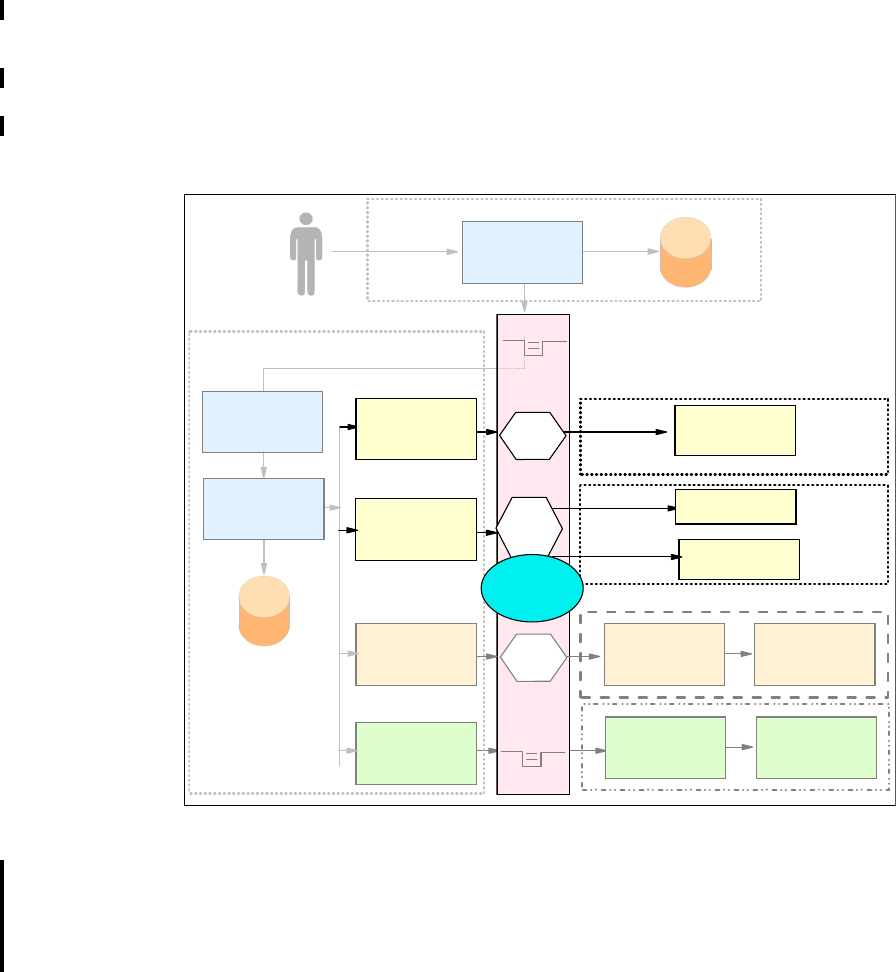
292 Patterns: Implementing Self-Service in an SOA Environment
10.1 Architectural overview model
The architectural overview model, shown in Figure 10-1, illustrates how the
ITSOMart application was extended to communicate with enterprise systems
using Web services.
The highlighted portion of Figure 10-1 is the focus of this chapter. From the J2EE
architecture point of view, this is the part of the application server business logic
tier that retrieves some business data from one or more applications in the EIS
tier. Results are retrieved and processed and sent back to the presentation tier.
Figure 10-1 Architectural overview model: Web services
The components that participate in the Web Services Scenario are:
CreditCheckProxy
This proxy is used by the Processor application to call the CreditCheck Web
service.
HTTP
Requests
Self Service
Application
Mail Sender
(MDB)
MailService
ESB
Processor
Mail Service Proxy
(JMS)
(MDB)
queue
JCA
Resource
Adapter
CRM (CICS)CRM Proxy
Web
service
queue
Processor.ear
CreditCheck
Proxy
CreditCheck
Web
service
HomeDelivery
Proxy
HomeDelivery
Web
service
BusinessDelivery
CreditCheck.ear
DeliverySystem.ear
Mediations
RoutingMediationsEJBEAR.ear
AggregatorEJBEAR.ear
Chapter 10. Web services scenario 293
HomeDeliveryProxy
The Processor application uses this proxy to call the HomeDelivery Web
service. The ESB intercepts the request and routes it to the appropriate
services.
Enterprise service bus (ESB)
The ESB is implemented using the service integration bus. The bus acts as
an intermediary for the Web service. Using an ESB insulates the application
from changes in the Web service location and provides the opportunity to
implement mediations or security measures in the future.
CreditCheck
The CreditCheck Web service returns a credit rating for the customer.
DeliverySystem
The DeliverySystem application has two Web services: HomeDelivery and
BusinessDelivery. These delivery systems create account numbers for the
new customer and return the information to the user.
This scenario illustrates the following three application patterns using Web
services technology:
Directly Integrated Single Channel application pattern:
ITSOMart calls a Web service that returns a customer credit rating. The rating
is used to determine whether to allow the customer to open an account.
Router application pattern
ITSOMart allows the user to select whether they want home delivery,
business delivery, or both. If home or business delivery is chosen the request
is routed to the appropriate service to assign an account number that is then
returned to the user. The routing is performed through the use of a mediation
in the ESB.
Decomposition application pattern
If the user selects both home delivery and business delivery, the request for
an account number is sent to both services. The responses with the account
numbers are aggregated into a single response for the customer. The
decomposition of the message into multiple messages and the recomposition
into a single response are performed through the use of a mediation in the
ESB.
Get Patterns: Implementing Self-Service in an SOA Environment now with the O’Reilly learning platform.
O’Reilly members experience books, live events, courses curated by job role, and more from O’Reilly and nearly 200 top publishers.

